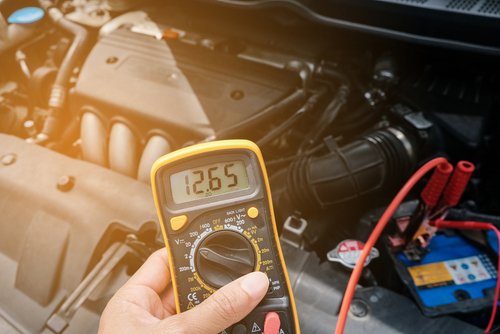Having a multimeter at home can be beneficial for testing old, unused batteries, appliances or power cords. Multimeters can also be used for testing vehicle electrical systems. If you are undertaking a DIY electrical repair or maintenance work, check out this guide on how to use a multimeter at home.
See also: How to read callipers?
What is a multimeter?
A multimeter is used to measure voltage (Volt), current (Amp) and resistance (Ohm). The device is commonly used by electricians.
The electrical properties that can be tested using a multimeter are:
- Alternate current (AC) used in the electrical wiring system at homes
- Direct current (DC) used in vehicles, residential solar power systems and consumer electronics
- Resistance in electrical circuits
- Current, that is, the electricity flowing in a circuit
Parts of a multimeter
- Display: A digital multimeter has an LCD that displays the readings in numerical form along with the unit of measurement. An analogue display includes a meter and an indicator that points to a number. Typically, there is a red line that indicates the value.
- Selection knob or button: Typically a round dial, it enables the user to set the multimeter to read different values, such as current (amps/ampere or M/milliamp), AC volt (in V), DC volt (in V) and resistance (in Ohm or Ω).
- Probes: A multimeter has red and black wires to test the electrical component. Each wire has a metal tip on one end and a plug on the other. While the black probe is neutral, the red probe is plugged into the port for measuring.
- Ports: The device has three ports but some varieties may have four.
- Scales: In an analogue multimeter, there are different types of scales, such as the DC/AC Voltage Scale and the DC/AC Current Scale.
How to use a multimeter?
Check the probes
Check if the probes are functioning. Set the device to ohm. Plug the black probe in the common port and the red probe in the jack marked ohm. Tap the red and black tips together. The reading should be 0.5 ohm or less.
Measuring AC voltage
Check the plug on an appliance or outlet to eliminate an electrical problem. Manually change the automatic function to the correct AC mode. Check an electrical plug or device by following these steps:
- Turn off the power. Set the multimeter to AC voltage.
- Start with a high range and dial it down. Set the multimeter to the correct unit to ensure safety and prevent blown fuses. Selecting a low range may cause problems.
- Set it higher than the voltage number mentioned on the cord. The setting is 120 volts for two-prong appliances and a higher voltage for three-prong appliances.
- Insert the black probe into the common jack and the red probe into the port labelled AC voltage.
- Put the end of the black probe into the neutral slot and the red probe in the hot slot on the plug.
- Measure the reading. Home appliances, such as a small hand mixer, maybe 120 volts, while a coffee grinder may be 300 volts. Unplug after testing the voltage by first removing the red probe and then the black from the appliance.
Measuring DC voltage
Devices such as a power bank or a battery with DC voltage can be measured using a multimeter.
- Disconnect the battery from any power tools or chargers.
- Set the multimeter to DC voltage.
- Using the knob, set it to the expected measurement.
- Plug the black probe in the common port and the red plug into the port marked for DC voltage.
- Place the black probe on the negative end of the battery and the red probe on the positive end.
- Measure the reading and unplug by first disconnecting the red probe and then the black probe.
Do not interchange the positive and negative sides of an analogue multimeter, as it can get damaged. However, when using a digital multimeter, if the reading is negative, switch the black and red probes to get a reading without a minus symbol.

Measuring resistance
- Disconnect the components from any live electric circuit, plugs and batteries to ensure zero current flow.
- Set the multimeter to ohm. Set it to the number marked in the resistor.
- Place the black probe in the common port and the red probe for DC voltage.
- You can measure around 200 ohms or higher. Some devices show a ‘1’ reading if the resistor has a higher capacity than the current setting.
- Put the probes on either side of the component being tested.
- Move down the ohm range gradually. The ‘1’ or ‘OL’ on a digital multimeter will change to a number.
- Turn down the range if proper reading is not displayed.
- Use alligator clip probes when testing multiple resistors.
Safety tips when using multimeters
- Before starting, check if all the parts are in proper condition.
- Do not touch the metal tips of the multimeter when testing with live current.
- To test the AC main, use a higher-category multimeter (rated Category II or above).
- Make sure you are wearing insulated gloves and footwear.
- Do not perform any testing or electrical work in wet conditions.
- Never use a broken multimeter or one with frayed wires on its probes.
FAQs
What is the most common use of a multimeter?
A multimeter is useful in DIY electrical projects to test wall outlets, batteries, power cords, appliances and vehicle electrical systems.
Is a multimeter AC or DC?
A multimeter can be used to measure both AC and DC voltage.
What is the symbol for AC voltage?
The voltage symbol in the multimeter is V.
Is a battery AC or DC?
A battery provides direct current (DC).
How to use a multimeter on a car?
Make sure the multimeter is turned off. Connect the positive lead to the positive terminal on the battery and the negative lead to a metal piece on the car’s frame. Turn on the multimeter to get the readings. If the reading is 12 volts or more, there is a current in the circuit. However, if it displays 0 volts, electricity is not moving through the circuit.
What are three things that a multimeter can measure?
Multimeters are commonly used to measure voltage, continuity and resistance in electrical components and circuits.
What are the two types of multimeters?
A multimeter is mainly of two types – analogue and digital.
| Got any questions or point of view on our article? We would love to hear from you. Write to our Editor-in-Chief Jhumur Ghosh at [email protected] |
Harini is a content management professional with over 12 years of experience. She has contributed articles for various domains, including real estate, finance, health and travel insurance and e-governance. She has in-depth experience in writing well-researched articles on property trends, infrastructure, taxation, real estate projects and related topics. A Bachelor of Science with Honours in Physics, Harini prefers reading motivational books and keeping abreast of the latest developments in the real estate sector.











